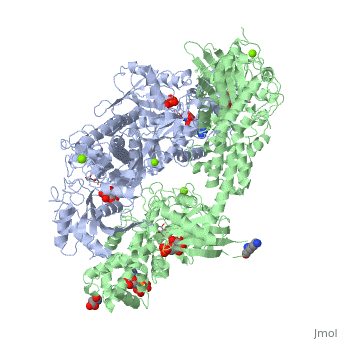Glycolysis Enzymes
From Proteopedia
(Difference between revisions)
| Line 2: | Line 2: | ||
Glycolysis is a key metabolic pathway for organisms. In it, glucose is converted into two pyruvate molecules. The process includes ten enzymes, described in further detail on the linked pages. | Glycolysis is a key metabolic pathway for organisms. In it, glucose is converted into two pyruvate molecules. The process includes ten enzymes, described in further detail on the linked pages. | ||
| - | The first phase of glycolysis is sometimes referred to as the "investment phase", where ATP is consumed to set up later, energy generating steps. The first step of the pathway is the conversion of glucose to glucose-6-phosphate by either hexokinase or glucokinase. Hexokinases should not be confused with glucokinase, which is a specific isoform of hexokinase. All hexokinases are capable of phosphorylating several hexoses but glucokinase acts with a 50-fold lower substrate affinity and its main hexose substrate is glucose.[https://en.wikipedia.org/wiki/Hexokinase] | + | The first phase of glycolysis is sometimes referred to as the "investment phase", where ATP is consumed to set up later, energy generating steps. |
| + | |||
| + | The first step of the pathway is the conversion of glucose to glucose-6-phosphate by either hexokinase or glucokinase. Hexokinases should not be confused with glucokinase, which is a specific isoform of hexokinase. All hexokinases are capable of phosphorylating several hexoses but glucokinase acts with a 50-fold lower substrate affinity and its main hexose substrate is glucose.[https://en.wikipedia.org/wiki/Hexokinase] | ||
| + | |||
'''Hexokinase:''' | '''Hexokinase:''' | ||
*[[The Structure and Mechanism of Hexokinase]] | *[[The Structure and Mechanism of Hexokinase]] | ||
| - | Glucose-6-phosphate isomerizes to fructose-6-phosphate; this reaction is catalyzed by [[Stancu_Phosphoglucoisomerase_Sandbox_1|phosphoglucoisomerase]]. This isomerization allows for the creation of two, three carbon sugars as a product. | + | |
| + | Glucose-6-phosphate isomerizes to fructose-6-phosphate; this reaction is catalyzed by [[Stancu_Phosphoglucoisomerase_Sandbox_1|phosphoglucoisomerase]]. This isomerization allows for the creation of two, three carbon sugars as a product. | ||
| + | |||
| + | '''Phosphoglucose isomerase''' | ||
| + | *[[Phosphoglucose isomerase]] | ||
| + | *[[Phosphoglucoisomerase]] | ||
| + | |||
| + | [[Phosphofructokinase_(PFK)|Phosphofructokinase]] catalyzes the second phosphorylation reaction, and is the most highly regulated step of the pathway. [[Austin_Drake_Sandbox|Aldolase]] catalyzes the retro-aldol cleavage of fructose 1,6-bisphosphate into two three carbon phosphosugars, dihydroxyacetone phosphate and glyceraldehyde-3-phosphate. The interconversion of these two sugars is catalyzed by [[Christian_Krenk_Sandbox|triose phosphate isomerase]], also referred to as TIM. | ||
The next five reactions are the "payoff" phase of glycolysis, where energy in the forms of ATP and NADH is generated. All of the subsequent reactions happen twice (once for each of the two glyceraldehyde 3 phosphate molecules generated from glucose). First, [[Nathan_Line_sandbox_3|glyceraldehyde-3-phosphate dehydrogenase]] oxidizes glyceraldehyde-3-phosphate, transferring a hydride to NAD+, generating NADH and H+. A phosphate ion is used instead of a water molecule, leading to the formation of 1,3-bisphosphoglycerate, a high energy compound. [[Shane_Harmon_Sandbox|Phosphoglycerate kinase]] catalyzes the transfer of a phosphate from the 1 position of 1,3-bisphosphoglycerate to ADP. This is the "break even" point of glycolysis: the two ATPs that were consumed in preparing for the cleavage have been now been regenerated, in addition to two molecules of NADH, which can be used to generate ATP through electron transport and oxidative phosphorylation. | The next five reactions are the "payoff" phase of glycolysis, where energy in the forms of ATP and NADH is generated. All of the subsequent reactions happen twice (once for each of the two glyceraldehyde 3 phosphate molecules generated from glucose). First, [[Nathan_Line_sandbox_3|glyceraldehyde-3-phosphate dehydrogenase]] oxidizes glyceraldehyde-3-phosphate, transferring a hydride to NAD+, generating NADH and H+. A phosphate ion is used instead of a water molecule, leading to the formation of 1,3-bisphosphoglycerate, a high energy compound. [[Shane_Harmon_Sandbox|Phosphoglycerate kinase]] catalyzes the transfer of a phosphate from the 1 position of 1,3-bisphosphoglycerate to ADP. This is the "break even" point of glycolysis: the two ATPs that were consumed in preparing for the cleavage have been now been regenerated, in addition to two molecules of NADH, which can be used to generate ATP through electron transport and oxidative phosphorylation. | ||
Revision as of 12:03, 11 July 2022
| |||||||||||
References
Proteopedia Page Contributors and Editors (what is this?)
Alexander Berchansky, Ann Taylor, David Canner, Jaime Prilusky

